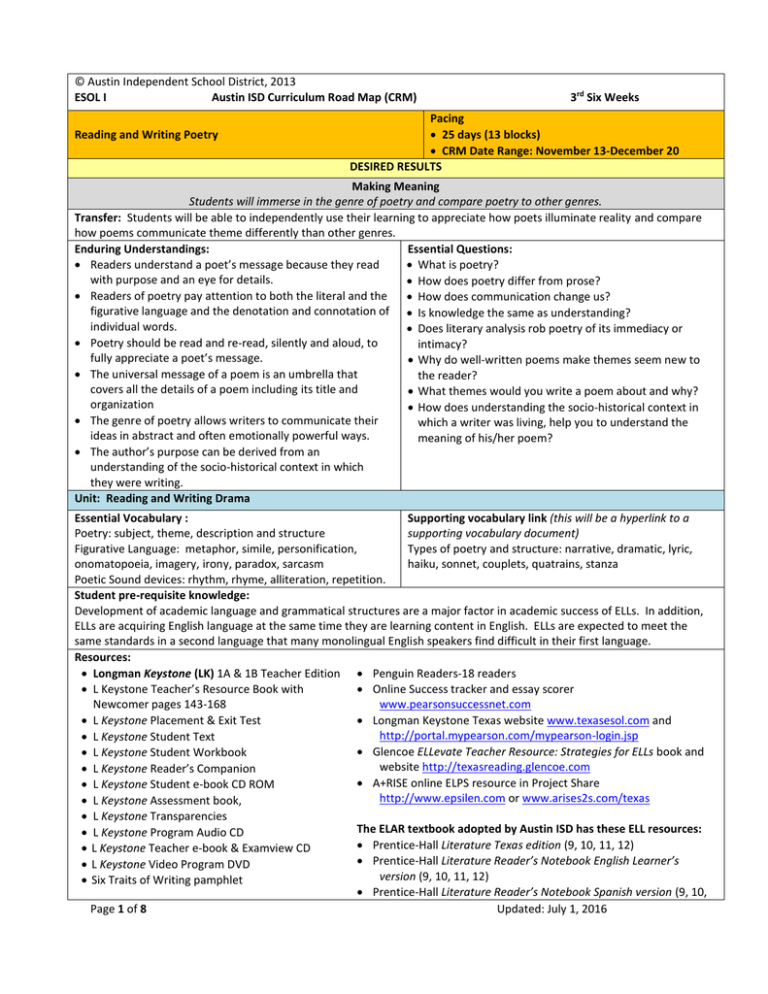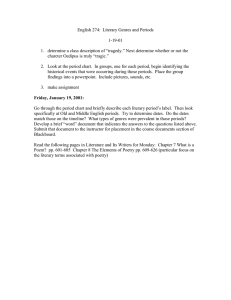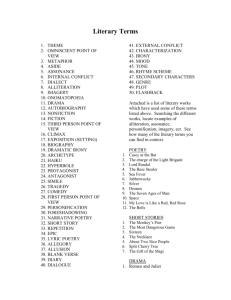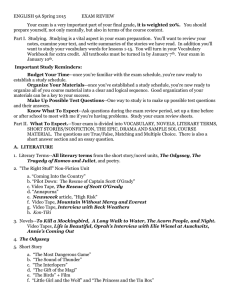3rd 6 Weeks ESOL Curriculum Road Map (CRM)
advertisement

© Austin Independent School District, 2013 ESOL I Austin ISD Curriculum Road Map (CRM) Reading and Writing Poetry 3rd Six Weeks Pacing 25 days (13 blocks) CRM Date Range: November 13-December 20 DESIRED RESULTS Making Meaning Students will immerse in the genre of poetry and compare poetry to other genres. Transfer: Students will be able to independently use their learning to appreciate how poets illuminate reality and compare how poems communicate theme differently than other genres. Enduring Understandings: Essential Questions: Readers understand a poet’s message because they read What is poetry? with purpose and an eye for details. How does poetry differ from prose? Readers of poetry pay attention to both the literal and the How does communication change us? figurative language and the denotation and connotation of Is knowledge the same as understanding? individual words. Does literary analysis rob poetry of its immediacy or Poetry should be read and re-read, silently and aloud, to intimacy? fully appreciate a poet’s message. Why do well-written poems make themes seem new to The universal message of a poem is an umbrella that the reader? covers all the details of a poem including its title and What themes would you write a poem about and why? organization How does understanding the socio-historical context in The genre of poetry allows writers to communicate their which a writer was living, help you to understand the ideas in abstract and often emotionally powerful ways. meaning of his/her poem? The author’s purpose can be derived from an understanding of the socio-historical context in which they were writing. Unit: Reading and Writing Drama Essential Vocabulary : Supporting vocabulary link (this will be a hyperlink to a Poetry: subject, theme, description and structure supporting vocabulary document) Figurative Language: metaphor, simile, personification, Types of poetry and structure: narrative, dramatic, lyric, onomatopoeia, imagery, irony, paradox, sarcasm haiku, sonnet, couplets, quatrains, stanza Poetic Sound devices: rhythm, rhyme, alliteration, repetition. Student pre-requisite knowledge: Development of academic language and grammatical structures are a major factor in academic success of ELLs. In addition, ELLs are acquiring English language at the same time they are learning content in English. ELLs are expected to meet the same standards in a second language that many monolingual English speakers find difficult in their first language. Resources: Longman Keystone (LK) 1A & 1B Teacher Edition Penguin Readers-18 readers L Keystone Teacher’s Resource Book with Online Success tracker and essay scorer Newcomer pages 143-168 www.pearsonsuccessnet.com L Keystone Placement & Exit Test Longman Keystone Texas website www.texasesol.com and http://portal.mypearson.com/mypearson-login.jsp L Keystone Student Text Glencoe ELLevate Teacher Resource: Strategies for ELLs book and L Keystone Student Workbook website http://texasreading.glencoe.com L Keystone Reader’s Companion A+RISE online ELPS resource in Project Share L Keystone Student e-book CD ROM http://www.epsilen.com or www.arises2s.com/texas L Keystone Assessment book, L Keystone Transparencies The ELAR textbook adopted by Austin ISD has these ELL resources: L Keystone Program Audio CD Prentice-Hall Literature Texas edition (9, 10, 11, 12) L Keystone Teacher e-book & Examview CD Prentice-Hall Literature Reader’s Notebook English Learner’s L Keystone Video Program DVD version (9, 10, 11, 12) Six Traits of Writing pamphlet Prentice-Hall Literature Reader’s Notebook Spanish version (9, 10, Page 1 of 8 Updated: July 1, 2016 11, 12) L Keystone Phonics Kit- includes flash cards, 5 student workbooks, 2 readers A & B, 1 Pearson Teacher’s Edition Language Central (9, 10, no 11 or 12) Teacher’s Edition www.PHLitOnline.com ELPS: Mandated by Texas Administrative Code (19 TAC §74.4), click on the link for English Language Proficiency Standards (ELPS) to support English Language Learners. ARC #1 : Introduction to Genre Arc Pacing: 1 week Targeted Vocabulary: same as above Resources: English 1 TEKS, Texas College and Career Readiness Standards (CCRS), Technology Application TEKS TEKS Knowledge & Skills Acquisition Important knowledge and skills STAAR: RC = Reporting Category; DC = Dual Students Will Know Students Will Be Able To Coded Skills; Readiness Standard; Supporting Standard Concepts are addressed in another unit. E1.3 Reading/Comprehension of Literary Text/Poetry. Students understand, make inferences and draw conclusions about the structure and elements of poetry and provide evidence from text to support their understanding. Student is expected to: (3A) analyze the effects of diction and imagery (e.g. controlling images, figurative language, understatement, overstatement, irony, paradox) in poetry RC2 Key vocabulary study is helpful for understanding diction and imagery. Analyze the effects of diction and imagery in poetry and provide evidence to support their analysis. Read materials with support of simplified text/visuals/word banks as needed. Show comprehension by predicting, making connections, drawing inferences and conclusions. Show comprehension of text through analytical skills. E1.7 Reading/Comprehension of Literary Text/Sensory Language. Students understand, make inferences and draw conclusions about how an author's sensory language creates imagery in literary text and provide evidence from text to support their understanding. Student is expected to: (7A) Explain the role of irony, sarcasm, and paradox in literary works RC2 Authors often use double meanings. Express the impact of sensory language on their understanding of a poem. Irony is a contradiction between appearance and reality. Show comprehension by predicting, making connections, drawing inferences and conclusions. Mature readers read a text on two levels – literal and symbolic. Use additional learning strategies such as reasoning, pattern identification, saying analysis. E1.14 Writing/Literary Texts: Students write literary texts to express their ideas and feelings about real or imagined people, events, and ideas. Students are responsible for at least two forms of literary writing. Student is expected to: (14B) Write a poem using a variety of poetic techniques (e.g., structural elements, figurative language) and a variety of poetic forms (e.g., sonnets, ballads) Key vocabulary study is helpful for understanding poetic techniques and forms. Express their ideas using poetic techniques in at least two different poetic forms. Use and reuse the variety of poetic techniques in discussion/writing activities. Write using acquired basic vocabulary Page 2 of 8 Updated: July 1, 2016 and content-based vocabulary. ARC #2 : Author’s Craft: Poetry Arc Pacing: 1 week Targeted Vocabulary: same as above Resources: English 1 TEKS, Texas College and Career Readiness Standards (CCRS), Technology Application TEKS TEKS Knowledge & Skills Acquisition Important knowledge and skills STAAR: RC = Reporting Category; DC = Students Will Know Students Will Be Able To Dual Coded Skills; Readiness Standard; Supporting Standard Concepts are addressed in another unit. E1.2 Reading/Comprehension of Literary Text/Theme and Genre. Students analyze, make inferences and draw conclusions about theme and genre in different cultural, historical, and contemporary contexts and provide evidence from the text to support their understanding. (2A) Analyze how the genre of texts Key figurative language vocabulary with similar themes shapes meaning study is helpful. RC1 Characteristics of literature can be (2B) analyze the influence of mythic, different depending on historical classical and traditional literature on and cultural contexts. 20th and 21st century literature RC2 Identify allusions to previous literary genres in contemporary literature. (2C) relate the figurative language of a literary work to its historical and cultural setting RC2 Provide evidence for the effect of a specific genre on the meaning of a particular theme. Discern the relationship between the use of figurative language and its historical and cultural setting. Show comprehension of text through analytical skills. Show comprehension by predicting, making connections, drawing inferences and conclusions. E1.3 Reading/Comprehension of Literary Text/Poetry. Students understand, make inferences and draw conclusions about the structure and elements of poetry and provide evidence from text to support their understanding. Student is expected to: (3A) analyze the effects of diction and Key vocabulary study is important Analyze the effects of diction and imagery (e.g. controlling images, for understanding diction and imagery in poetry and provide figurative language, understatement, imagery. evidence to support their analysis. overstatement, irony, paradox) in poetry Read materials with support of RC2 simplified text/visuals/word banks as needed. Show comprehension by predicting, making connections, drawing inferences and conclusions. Show comprehension of text through analytical skills. E1.7 Reading/Comprehension of Literary Text/Sensory Language. Students understand, make inferences and draw conclusions about how an author's sensory language creates imagery in literary text and provide evidence from text to support their understanding. Student is expected to: (7A) Explain the role of irony, sarcasm, Key vocabulary study is important Express the impact of sensory and paradox in literary works RC2 for understanding sensory language on their understanding of language. a poem. Page 3 of 8 Updated: July 1, 2016 Show comprehension by predicting, making connections, drawing inferences and conclusions. Use additional learning strategies such as reasoning, pattern identification, saying analysis. . E1.14 Writing/Literary Texts: Students write literary texts to express their ideas and feelings about real or imagined people, events, and ideas. Students are responsible for at least two forms of literary writing. Student is expected to: (14B) Write a poem using a variety of poetic techniques (e.g., structural elements, figurative language) and a variety of poetic forms (e.g., sonnets, ballads) Key vocabulary study is helpful for understanding poetic techniques and forms. Write two poems using a variety of poetic techniques in two poetic forms. Use and reuse the variety of poetic techniques in discussion/writing activities. Write using acquired basic vocabulary. ARC #3 : Author’s Craft: Poetry and Literary-Nonfiction Arc Pacing: 2 weeks Targeted Vocabulary: same as above Resources: English 1 TEKS, Texas College and Career Readiness Standards (CCRS), Technology Application TEKS TEKS Knowledge & Skills Acquisition Important knowledge and skills STAAR: RC = Reporting Category; DC = Students Will Know Students Will Be Able To Dual Coded Skills; Readiness Standard; Supporting Standard Concepts are addressed in another unit. E1.3 Reading/Comprehension of Literary Text/Poetry. Students understand, make inferences and draw conclusions about the structure and elements of poetry and provide evidence from text to support their understanding. Student is expected to: (3A) analyze the effects of diction and imagery (e.g. controlling images, figurative language, understatement, overstatement, irony, paradox) in poetry RC2 Key vocabulary study is important for understanding diction and imagery. Analyze the effects of diction and imagery in poetry and provide evidence to support their analysis. Read materials with support of simplified text/visuals/word banks as needed. Show comprehension by predicting, making connections, drawing inferences and conclusions. Show comprehension of text through analytical skills. E1.7 Reading/Comprehension of Literary Text/Sensory Language. Students understand, make inferences and draw conclusions about how an author's sensory language creates imagery in literary text and provide evidence from text to support their understanding. Student is expected to: (7A) Explain the role of irony, sarcasm, Authors often use double meanings. Express the impact of sensory and paradox in literary works RC2 language on their understanding of Irony is a contradiction between a poem. appearance and reality. Use additional learning strategies Mature readers read a text on two such as reasoning, pattern levels – literal and symbolic. Page 4 of 8 Updated: July 1, 2016 identification, saying analysis. Show comprehension by predicting, making connections, drawing inferences and conclusions. E1.14 Writing/Literary Texts: Students write literary texts to express their ideas and feelings about real or imagined people, events, and ideas. Students are responsible for at least two forms of literary writing. Student is expected to: (14A) write an engaging story with a well-developed conflict and resolution, interesting and believable characters, and a range of literary strategies (e.g., dialogue, suspense) and devices to enhance the plot RC4 Stories contain key aspects and key literary strategies. ARC #4 : Author’s Craft: Poetry and Informational Texts Write a story with a plot enhanced by literary strategies and devices. Write using a variety of grade appropriate sentence lengths, patterns and connecting words to combine phrases, clauses, and sentences in increasingly accurate ways. Narrate, describe, and explain with increasing specificity and detail to fulfill content area writing needs as more English is acquired. Arc Pacing: 2 week Targeted Vocabulary: same as above Resources: English 1 TEKS, Texas College and Career Readiness Standards (CCRS), Technology Application TEKS TEKS Knowledge & Skills Acquisition Important knowledge and skills STAAR: RC = Reporting Category; DC = Students Will Know Students Will Be Able To Dual Coded Skills; Readiness Standard; Supporting Standard Concepts are addressed in another unit. E1.3 Reading/Comprehension of Literary Text/Poetry. Students understand, make inferences and draw conclusions about the structure and elements of poetry and provide evidence from text to support their understanding. Student is expected to: (3A) analyze the effects of diction and imagery (e.g. controlling images, figurative language, understatement, overstatement, irony, paradox) in poetry RC2 Key vocabulary study is important for understanding diction and imagery. Analyze the effects of diction and imagery in poetry and provide evidence to support their analysis. Read materials with support of simplified text/visuals/word banks as needed. Show comprehension by predicting, making connections, drawing inferences and conclusions. Show comprehension of text through analytical skills. E1.7 Reading/Comprehension of Literary Text/Sensory Language. Students understand, make inferences and draw conclusions about how an author's sensory language creates imagery in literary text and provide evidence from text to support their understanding. Student is expected to: (7A) Explain the role of irony, sarcasm, Key vocabulary study is important Express the impact of sensory and paradox in literary works RC2 for understanding sensory language on their understanding of language. a poem. Show comprehension by predicting, making connections, drawing Page 5 of 8 Updated: July 1, 2016 inferences and conclusions. Use additional learning strategies such as reasoning, pattern identification, saying analysis. E1.15 Writing/Expository and Procedural Texts. Students write expository and procedural or work-related texts to communicate ideas and information to specific audiences for specific purposes. Student is expected to: (15Ai) effective introductory and Being mindful of the organizational Write an expository and procedural concluding paragraphs and a variety of structures of expository and text. sentence structures RC4/RC5 procedural texts aids in Use rhetorical devices, thesis, and (15Aii) rhetorical devices, and understanding. transitions. transitions between paragraphs Authors use rhetorical devices, Write using a variety of sentence RC4/RC5 thesis, and transitions. lengths, patterns, and connecting (15Aiii) a controlling idea or thesis words to combine phrases, clauses, RC4/RC5 and sentences in increasingly (15Aiv) an organizing structure accurate ways as more English is appropriate to purpose, audience, and acquired. context RC4/RC5 Narrate, describe, and explain with (15Av) relevant information and valid increasing specificity and detail to inferences RC4/RC5 fulfill content-area writing needs as more English is acquired. Page 6 of 8 Updated: July 1, 2016 ASSESSMENT EVIDENCE TEA mandate requires the use of linguistic accommodations for ELLs as determined by the LPAC. Data is available from the LPAS (Language Proficiency Assessment System.) Refer to http://www.tea.state.tx.us/student.assessment/accommodations Student Work Products/Assessment Evidence Performance Tasks Other Evidence (i.e. unit tests, open ended exams, quiz, essay, student work samples, observations, etc.) Choose from the tasks below based on ELL proficiency level and your pacing. Explain to the class the use of one metacognitive technique the student used to understand while they were reading. Listen to a stand-up comedian perform and identify elements of sarcasm, irony. Compare and contrast two poems one with figurative language and one without. Explain the impact that the use of figurative language has on the reader. Students will use a graphic organizer to plan and write a story with engaging literary devices. Compare and contrast two stories, one well written and one without use of literary devices. Demonstrate the use of reading strategies to identify main ideas and author purpose. Write a summary which traces the logic of an argument. Write an expository and a procedural essay using graphic organizer. Short Cycle Assessment 3rd Six Weeks SCA Tested TEKS: 1A, 7, 7A Poem: 3,3A,F19B Literary Nonfiction: 6,6A, 9A,9C,F19B Window: December 12-20th Eligible ELLs may use linguistic accommodations when taking SCAs or other assessments. Refer to http://www.tea.state.tx.us/student.assessment/accommodations/ Additional Suggestions for Assessment Observations by teachers and administrators of Reader/Writer Notebook, Vocabulary Development, Active Reading Strategies, and Effective Group Learning, Accountable Talk. Texas Skill Builder Test Poetry sharing with class or in pairs. Quiz on Academic language. Identify ironic, sarcastic and paradoxical elements within a text. Use Marzano’s six steps for vocabulary development and ESOL text book 1B. Create a drawing illustrating a sensory imagery used in a poem. Write two different poems using different poetic techniques. Neologisms: Create new words using Latin, Greek and other roots and affixes. Write a poem that reflects a current aspect of our culture. Use figurative language. The class will be expected to guess the theme through oral response. Page 7 of 8 Updated: July 1, 2016 LESSON PLANNING TOOLS Teacher Notes 1. Additional text selections at different lexile levels are available in the Resources section, p 2 of this CRM. (See link: Prentice Hall Literature Texas edition, (Selections by Grade, Genre, and Lexile, English II Writing Resources) 2. Several lessons are included for each arc. Choose lessons based on proficiency of your ELLs and pacing considerations. In the course of lesson planning, it is the expectation that teachers will include whole child considerations when planning such as differentiation, special education, English language learning, dual language, gifted and talented, social emotional learning, physical activity, and wellness. ESOL Exemplar Lesson 1- Arc 1: Introduction to Genre: Poetry. Suggested Pacing: 2 days/1 block TEKS: 3, 3A, 14B ESOL Exemplar Lesson 2 – Arc 1: Introduction to Genre: Poetry. Prentice-Hall Literature Reader’s Notebook English Learner’s version (grade 9) “The Cask of Amontillado” pp. 38-42 Suggested Pacing: 2 blocks TEKS: 3, 3A, 14, 14B ELA Exemplar Lesson - Arc 1: Introduction to Poetry Suggested Pacing: 1 block TEKS: 2, 2A, 3, 3A, 14, 14A, 14B ESOL Exemplar Lesson 1 - Arc 2: Author’s Craft: Poetry. Longman Keystone 1A “Tiny Giant” pp. 206-212 Suggested Pacing: 3 days TEKS: 3, 3A, 14, 14B ELA Exemplar Lesson 2 – Arc 2: Suggested Pacing: TEKS: 2, 2A, 2B, 2C, 3, 3A, 7, 7A, 14, 14 ESOL Exemplar Lesson 1 – Arc 3: Author’s Craft: Poetry and Literary Nonfiction. Longman Keystone 1A “Writing Process Handbook” pp.T344-349, Writing Workshop, Longman Keystone 1B “Expository Essay” pp. T402-405 Suggested Pacing: 3 blocks TEKS: 2, 2A, 3, 3A, 14, 14B ELA Model Lesson 2 - Arc 3: Comparing Poetry and Literary Nonfiction Suggested Pacing: 1 block TEKS: 2 , 2A, 3, 14, 14B ESOL Exemplar Lesson 1 – Arc 4: Author’s Craft: Poetry and Informational Text. ELA Model Lesson 2- Arc 4: Comparing Informational Text and Poetry Suggested Pacing: 1 block TEKS: 3 , 3A 9, 9C Instructional Resources www.starfall.com Austin ISD ELL Academic Plan 2013-2014, Resources pp. 160-164. (hyperlink takes you to aisdweb intranet) www.eflnet.com Navigating the ELPS in the English Language Arts and Reading Classroom: www.pumarosa.com Using the Standards to improve instruction for ELLs, (J. Seiditz). www.daveseslcafe.com English I STAAR Writing Resources www.colorincolorado.com Page 8 of 8 Updated: July 1, 2016






